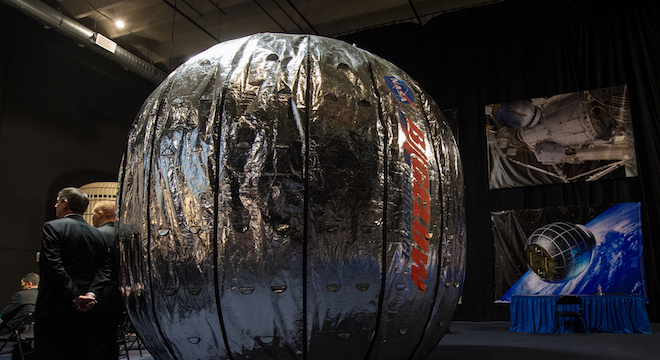NASA on Wednesday announced it had awarded $17.8 million to Bigelow Aerospace, a North Las Vegas private spacefaring company, to test a new inflatable habitat for the International Space Station over a 2-year-period beginning in 2015.
The inflatable module, a balloon-like cylindrical structure called the Bigelow Expandable Activity Module (BEAM) is made of multiple layers of Vectran, a bullet-resistant polymer, coated with the same type of shielding foil used to encase other hard spacecraft material, as New Scientist previously reported.
BEAM will be flown to the space station uninflated, folded up and stowed away aboard a spacecraft by yet another private company, SpaceX‘s Dragon. When it gets to the space station, it will be installed by the station’s robotic arm and then puffed up to full size using a pressurization system, expanding to 13 feet long, 10 feet wide, and 560 cubic feet in volume, as the New York Times reported.
Check out the following video illustration of the planned installation process posted online by NASA on Wednesday:
During the two year test period, BEAM will remain inflated and astronauts in space and engineers back on Earth will collect performance data on how it compares to the traditional aluminum hard-bodied craft and modules when it comes to shielding against radiation, temperature balance, structural integrity and air-tightness.
Astronauts aboard the hard-shell part of the station are also set to “periodically will enter the [BEAM] module,” according to NASA.
But even if BEAM performs flawlessly, its time as a space station addition is limited. After the two-year test run, it is due to be disconnected from the station and deorbited, burning up in Earth’s atmosphere upon reentry.
Still, the data gathered during the test run will be important for the future ambitions of both NASA and Bigelow. NASA gains by potentially designing its own new spacecraft for travel to Mars or an asteroid, or for the design of a Moon base. Bigelow would further its own longstanding plans to launch the world’s first private space station, codenamed “Alpha,” due to be assembled in space entirely from the same type of inflatable modules, the first of which could launch as early as 2016. Bigelow eventually plans to use that station both as scientific laboratory for the world’s space agencies, and for space tourism, taking civilian spacefarers up for two months at a time for $26.25 million, also aboard SpaceX’s Dragon.
There are several advantages to inflatable space habitats over their traditional hard-shell counterparts: Their relatively light weight and small form when folded-up makes them far cheaper and easier cargo to launch, and they could even be safer and more comfortable for astronauts, as the New York Times reported:
“Even if punctured by a high-speed meteorite, the fabric does not tear. A hole in a metal structure in space, by comparison, can cause explosive decompression as air rushes out.
When the Beam module reaches the space station, astronauts might go to it to seek solitude: engineers expect it will be the quietest spot there. The fabric walls absorb sound vibrations instead of transmitting them.”
Bigelow also promotes its inflatable BEAM and other designs as more useful and space-efficient when fully inflated and operational, pointing out on its website that the current solid aluminum modules aboard the space station are designed such that most equipment is stored in the walls. By contrast:
“Our equipment is centrally located and packed in the core while the astronauts live in the large expansion volume surrounding the equipment core. This innovation allows equipment access from all sides and directions rather than limited to one front panel. Via the quantum leap in volume provided by expandable habitats, Bigelow Aerospace will be able to far exceed the useable value of the ISS at a fraction of the cost.”
Bigelow was founded in 1999 by Robert T. Bigelow, owner of the Budget chain of hotels. The company already launched two previous unmanned inflatable orbital spacecraft, the Genesis I and Genesis II, in 2006 and 2007 respectively. Both are still in orbit and have retained their structural integrity.
Inflatable spacecraft have been a goal for some time, as the following gallery shows:

Separately, inflatable hardware has also gained traction in robotics here on Earth, indicating that the future may be populated by such equipment.






